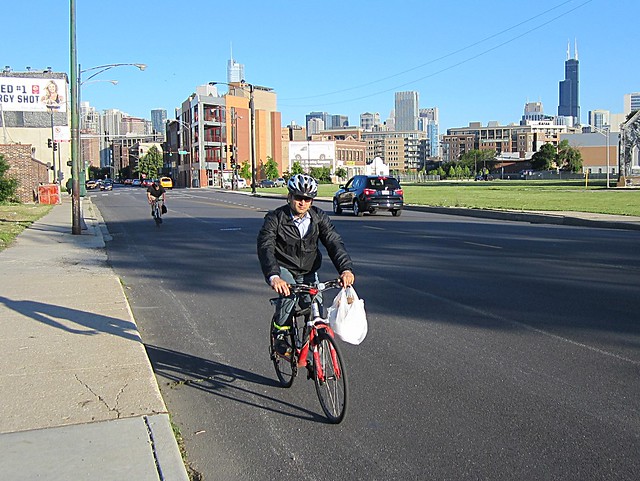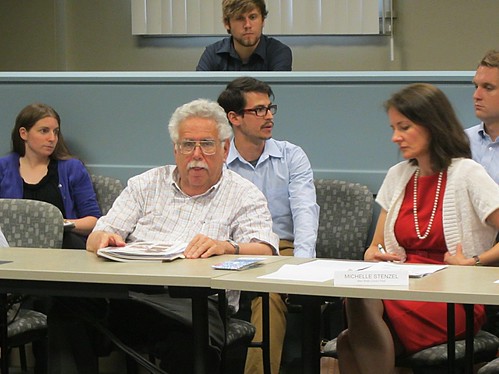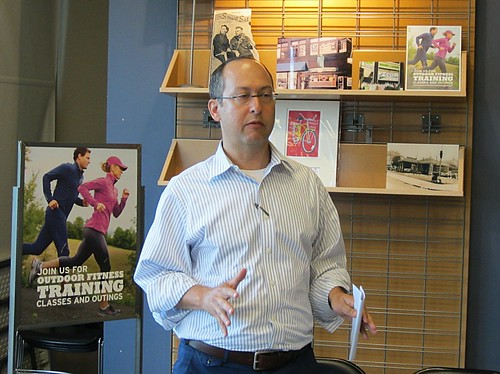This February, Steven Vance reported that the Illinois Department of Transportation has been prohibiting the installation of protected bike lanes on state jurisdiction roads in Chicago at least until the Chicago Department of Transportation collects three years of “safety data” on existing Chicago protected lanes. That means the earliest the ban would be lifted would be July 2014, three years after Chicago’s first protected lanes opened on Kinzie. IDOT is not blocking installation of buffered lanes.
IDOT’s anti-protected lane policy came into sharp focus after cyclist Robert “Bobby” Cann was fatally struck by an allegedly drunk, speeding driver, on Clybourn Avenue, a state jurisdiction street, on May 29. Chicago’s Streets for Cycling Plan 2020 designates Clybourn as a bike-priority “Spoke Route,” and the street is wide enough for protected lanes. Had IDOT not been blocking protected lanes on Clybourn, it’s possible that the city would have built them prior to the crash.
The circumstances of Cann’s death are still unclear and, since the crash may have happened in an intersection, it’s not certain that PBLs would have shielded Cann from an out-of-control driver. However, protected bike lanes on Clybourn could definitely help prevent similar tragedies. Since protected lanes are off the table, CDOT has announced plans to stripe buffered lanes, which do not shield cyclists from cars, on Clybourn from Division to Belmont, with construction likely starting this week. IDOT is cooperating with the project.
At last Wednesday’s Mayor’s Bicycle Advisory Council meeting at City Hall, attorney Brendan Kevenides (a Streetsblog Chicago sponsor) asked IDOT Project Engineer Aren Kriks why his department is prohibiting protected bike lanes on streets like Clybourn, despite evidence from other cities that protected lanes improve safety for all road users. CDOT Deputy Commissioner Luann Hamilton was involved in the discussion, as was I. Here’s a transcript.
Brendan Kevenides: I did have a question I wanted to pose to the IDOT guy if I may. As many of us know, Bobby Cann was killed by a drunk driver who was speeding on May 29th. As [CDOT Commissioner] Gabe Klein mentioned at the beginning of this meeting, it’s not’s not quite clear whether he was killed in the intersection or on Clybourn but it’s been reported that there’s a desire among CDOT and many other cyclists in Chicago to have car-protected bike lanes on Clybourn and on other streets.
As I understand it, and correct me if I’m wrong, CDOT has either proposed a car-protected bike lane on Clybourn or at least stated that it wants it. My understanding is that IDOT is blocking that.
Luann Hamilton: That’s not really accurate. I can speak to this.
BK: Well, it’s been reported, so I wanted to…
LH: They have our plans under review, so we haven’t gotten all their responses yet and we’re supposed to get them this week. They didn’t block it, they’re just going through their process and it just takes a while.
John Greenfield: But there’s a blanket ban on barrier-protected bike lanes on IDOT roads.
LH: Well, if it’s on state jurisdiction roads there’s a ban.
BK: Right, that’s what I’m saying and Clybourn, as I understand it, is under IDOT control [it is]. That’s why I mentioned Clybourn specifically. It’s been reported that it’s because there’s not enough data and that IDOT wants three years of data. There’s plenty of data from places like New York who’ve used protected bike lanes for a while and I guess, respectfully, the one piece of data we got on May 29th seems awfully powerful. Could you explain why IDOT doesn’t want protected bike lanes on Streets like Clybourn that are…
LH: I don’t think it’s really fair to ask a staff person a policy-level question. Do not comment on that.
Aren Kriks: I mean, I can speak to it just a little bit. As you said, really that is a policy-level thing, but I can say that, especially in light of everything that’s happening right now, these studies are taking place and it’s driven us to start a district bicycle and pedestrian study where, you know, the state bike plan is going on right now. And this is meant to look at the current policies, and we will be changing them in the future. But, as most people in this room know, these changes won’t happen overnight.
This one [crash] will probably bring to light, be a driving force to help get these studies going again. But whether or not the change is going to happen immediately at the state level, I can’t say. I can say that we’re studying it. That’s really all I can offer.
In comparison to a place like New York, we’re looking at state policies. When you get into counties and local practices, it might not be comparing the same thing necessarily. I don’t know if that answers the question but I can say that we are studying accommodations like protected bike lanes, whereas previously they were not being studied.
BK: So if I’m understanding you, and I know you might not be in a position to answer this, we may not have to wait for three years of data.
LH: No, he’s not is a position to answer that. I don’t think it’s fair. I’m going to cut it off.







